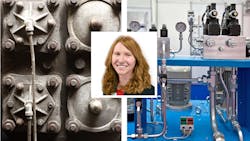Electrification may be the “hot” topic at the moment in many industries, particularly those related to mobility, but it’s important to remember so-called traditional technologies will continue to have their place.
As our upcoming April cover story shows, there will still be a need for hydraulic components and systems. Yes, there are many efficiency gains which can be achieved through the use of electrohydraulic components, and the trend toward more incorporation of electronics into hydraulics is likely to continue. But as Mitch Eicher of Parker Hannifin points out in the piece, traditional hydraulic components will remain critical to systems where the flow rate, pressure or actuators need to be controlled.
He goes on to say that the speed and force necessary, as well as energy consumed, would be both size- and cost-prohibitive using electromechanical solutions to drive all components. Therefore, components such as hydraulic valves will remain necessary in many applications.
The key going forward for design teams will be understanding how best to bring new and traditional technologies together. This will lead to more of a systems design approach, one which Eicher says Parker Hannifin—and many other companies—is employing.
As he states in the article, it is no longer about questioning whether to go the hydraulics, pneumatics or electromechanical route but instead looking at system solutions. “Our focus in our manufacturing division is hydraulic valves but, as electrification comes, those valves are getting smarter. In some applications, they may be going more electromechanical for their control or for certain components.”
Bringing new and traditional technologies together can help to better optimize performance of a system or machine. It can also offer opportunities for improvements to traditional systems and components such as simplified designs.
This pairing of the “new and old” can be seen as a bit of a metaphor for the direction of Power & Motion, as well. While continuing to cover traditional hydraulics and pneumatics technologies, it would be remiss not to also be covering what technologies are coming and being utilized alongside hydraulic and pneumatic components.
As many in the industry continue to say, it’s an exciting time due to the new technologies entering the market and how they’re being blended with what already exists. Technology and how it’s designed will continue to evolve, and we look forward to seeing—and covering—that evolution.
About the Author
Sara Jensen
Executive Editor, Power & Motion
Sara Jensen is executive editor of Power & Motion, directing expanded coverage into the modern fluid power space, as well as mechatronic and smart technologies. She has over 15 years of publishing experience. Prior to Power & Motion she spent 11 years with a trade publication for engineers of heavy-duty equipment, the last 3 of which were as the editor and brand lead. Over the course of her time in the B2B industry, Sara has gained an extensive knowledge of various heavy-duty equipment industries — including construction, agriculture, mining and on-road trucks —along with the systems and market trends which impact them such as fluid power and electronic motion control technologies.
You can follow Sara and Power & Motion via the following social media handles:
X (formerly Twitter): @TechnlgyEditor and @PowerMotionTech
LinkedIn: @SaraJensen and @Power&Motion
Facebook: @PowerMotionTech

Leaders relevant to this article:

